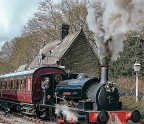GREAT STEAM ENGINEERS OF THE NINETEENTH CENTURY PART THREE: THE 1830s

The 1830s saw the railway building mania accelerate dramatically. While many leading locomotive engineers formed specialist locomotive building companies, larger rail firms began to establish their own in-house resources.
Edward Bury was one of the engineers who set up his own locomotive building company. Born in Salford, Lancashire in 1794, he was the son of a timber merchant and was educated in Chester. By 1823 he was a partner in Gregson and Bury’s steam sawmill at Toxteth Park, but in 1826 he set himself up as an iron-founder and engineer. His original premises were in Tabley Street near the Liverpool and Manchester Railway’s (L&MR) workshops. He hoped to supply locomotives to that line, but opposition from the L&MR engineer, George Stephenson, thwarted this.
He moved his works to new premises in Love Lane, Liverpool, on the Leeds and Liverpool Canal. Around this time he recruited as his manager James Kennedy, who had gained locomotive building experience working for George Stephenson and Mather, Dixon and Co. The first locomotive built by Edward Bury and Co in Liverpool, Dreadnought, was intended to compete in the Rainhill trials, but could not be finished in time. His second locomotive, Liverpool, had four 6ft diameter driving wheels, and although it was tried on the Liverpool and Manchester, Stephenson thought the size of the wheels was dangerous.
combined near-horizontal inside cylinders with a multi-tubular boiler and a round dome-topped firebox, but differed from what was becoming accepted practice in that it had a simple wrought-iron bar-frame inside the wheels, rather than wooden outside frames and inside iron sub-frames. This was a well thought-out and advanced design, which lasted. Mostfollowed this same basic design, which was copied by other firms in Europe and the US.
You’re reading a preview, subscribe to read more.
Start your free 30 days

